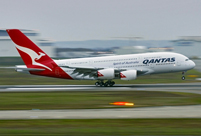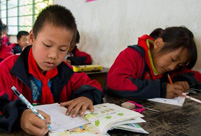 'Model husband' shatters image of love
'Model husband' shatters image of love
 Can animals smile? Or put on a happy face
Can animals smile? Or put on a happy face
 Geng Xuan crowned at 9th China Super Model Contest
Geng Xuan crowned at 9th China Super Model Contest
 Top 10 billionaires in the liquor industry
Top 10 billionaires in the liquor industry
 Backstage at China Fashion Week
Backstage at China Fashion Week
 Ballerinas anywhere but onstage
Ballerinas anywhere but onstage
 Top 10 safest airlines in the world
Top 10 safest airlines in the world
 Posters of 33rd HK Film Awards unveiled
Posters of 33rd HK Film Awards unveiled
 Top 10 most popular instant messaging apps in the world
Top 10 most popular instant messaging apps in the world
 Inspiring shadow images of Chinese army
Inspiring shadow images of Chinese army
BOAO, Hainan, April 9 -- It might be a bad time for Chinese manufacturers as the economic slowdown and restructuring squeeze their profit margins. It could also be good for them too, if they can embrace innovation to move up the value chain.
The good old days for China's low-cost manufacturers are gone. They now feel the pinch due to factors including mounting excess capacity, rising labor costs and increasing international competition.
"We found that China's industrial revolution was less technologically innovative compared with Britain and the United States," said Nobel Prize Laureate Ronald Harry Coase at the ongoing Boao Forum for Asia (BFA) 2014 Annual Conference.
"This was disturbing and unfortunate, particular since the modern economy has become more and more knowledge-driven," said Coase, one of ten delegates who questioned over 40 Chinese entrepreneurs on their innovation willingness and capability at the forum.
MOVING UP THE LADDER
For Chinese iPhone fans, they may lament as their smartphone screens are made by overseas manufacturers. But they may feel a little relieved if they know that the super glass walls of some Apple stores are made by a Chinese glass manufacturer.
"The market for ordinary glass is getting smaller with increasing competition and decreasing margins. The only way to survive is to move up the value chain through innovation," said Dou Qinghe, vice president of AVIC Glass, a specialist glass maker in south China's Hainan Province.
Like Dou, more Chinese entrepreneurs are racing to catch up with international competitors using expertise, talent and financial firepower.
"The speed of innovation is much higher than that in the west. Just think about how China looked 30 years ago, now you see first-class technical universities cooperating with Chinese industries to further innovate," said Ernst Ulrich von Weizsacker, co-President of the Club of Rome.
According to a report released by the World Intellectual Property Organization in March, China ranked third in total international patent applications to the Patent Cooperation Treaty, with over 20,000 applications, up 15.6 percent year on year.
"China is very responsive and receptive to innovative ideas and sectors, such as e-commerce and Internet finance. The embrace for such innovations in turn facilitate further reforms by helping nurture a multi-tier and freer capital market," said Gregory D. Gibb, Chairman and CEO of Shanghai Lujiazui International Financial Asset Exchange Co., Ltd.
"I believe some sectors may even outperform the United States and Europe in three to five years thanks to their innovation-driven growth," Gibb added.

 Wonderful moment of China's airborne forces
Wonderful moment of China's airborne forces Bai Baihe shoots for fashion magazine
Bai Baihe shoots for fashion magazine Red terraced fields in Dongchuan of Yunnan
Red terraced fields in Dongchuan of Yunnan Jiaju Tibetan Village
Jiaju Tibetan Village Spring dating
Spring dating Confucius institute at UC Davis
Confucius institute at UC Davis Little painted faces at temple fair
Little painted faces at temple fair Top 10 safest airlines in the world
Top 10 safest airlines in the world Foreign students at China-Myanmar border
Foreign students at China-Myanmar border The backstage of the Fashion Week
The backstage of the Fashion Week College students in Han costumes
College students in Han costumes Postgraduate works as waitress
Postgraduate works as waitress Life in a Lahu village in Yunnan
Life in a Lahu village in Yunnan An orphan’s wedding
An orphan’s wedding Hollywood documentary brings Diaoyu Islands truth to new audience
Hollywood documentary brings Diaoyu Islands truth to new audienceDay|Week|Month